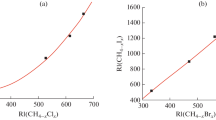Abstract
The traditional approach to calculations of gas-chromatographic retention indices from physicochemical constants of organic compounds in homologous series does not encompass all possible objects. Forming different taxonomic groups of compounds by variations in the formal unsaturation, the number of atoms of different elements within molecules, or any complex fragments of structure/composition makes it possible to calculate unknown retention indices by several independent methods from different arrays of initial data. The application of simple three-parameter equations provides an accuracy comparable to the modern interlaboratory error of determination of retention indices for any compounds.
Similar content being viewed by others
References
M. S. Wigdergaus, L. V. Semenchenko, V. A. Ezrets, and Yu. N. Bogoslovskii, inQualitative Gas-Chromatographic Analysis [in Russian], Nauka, Moscow (1977).
I. G. Zenkevich,Zh. Anal. Khim.,39, No. 7, 1297–1307 (1984).
R. Kaliszan, inQuantitative Structure—Chromatographic Retention Relationships, Wiley, New York (1987), p. 303.
V. M. Nabivach and V. P. Dmitrikov,Usp. Khim.,62, No. 1, 27–38 (1993).
I. G. Zenkevich and L. M. Kuznetsova,Collect. Czech. Chem. Commun.,56, 2042–2056 (1991).
I. G. Zenkevich and L. M. Kuznetsova,Zh. Anal. Khim.,47, No. 6, 982–993 (1992).
K. Heberger,Chromatogr.,29, No. 7/8, 375–384 (1990).
K. Heberger,Anal. Chim. Acta,223, 161–174 (1989).
Yu. A. Zhdanov, inHomology in Organic Chemistry [in Russian], Moscow State University, Moscow (1950).
B. V. Ioffe,Refractometric Methods in Chemistry [in Russian], Khimiya, Leningrad (1974).
I. G. Zenkevich and S. V. Konyukhova,Vestn. Sankt-Peterb. Gos. Univ., Ser. Fiz. Khim., No. 1, 66–70 (1992).
I. G. Zenkevich, I. A. Tsibulskaya, and A. A. Rodin,Zh. Alan. Khim.,46, No. 1, 101–110 (1991).
I. G. Zenkevich, S. V. Konyukhova, and B. N. Maksimov,Zh. Fiz. Khim.,67, No. 7, 1474–1479 (1993).
Beilstein Handbuch der Organischen Chemie, Vol. I-XXXI, 4th edition, Springer-Verlag, Berlin (1918).
Additional information
St. Petersburg State University. Translated fromZhurnal Strukturnoi Khimii, Vol. 35, No. 6, pp. 176–182, November–December, 1994.
Translated by L. Smolina
Rights and permissions
About this article
Cite this article
Zenkevich, I.G. Forming taxonomic groups of organic compounds for calculating gas-chromatographic retention indices from physicochemical constants. J Struct Chem 35, 906–911 (1994). https://doi.org/10.1007/BF02578124
Received:
Issue Date:
DOI: https://doi.org/10.1007/BF02578124




